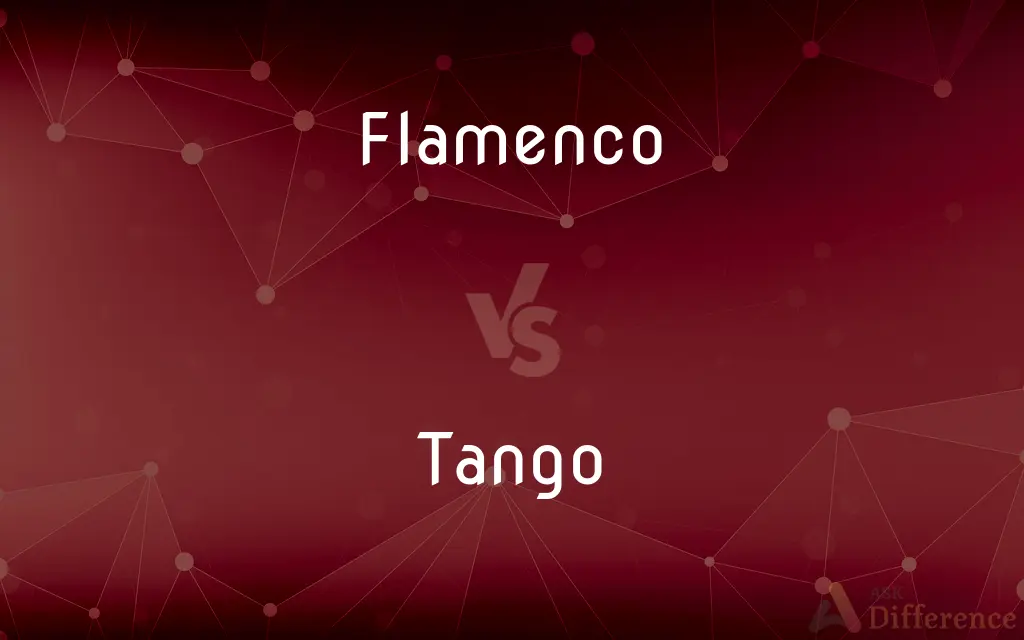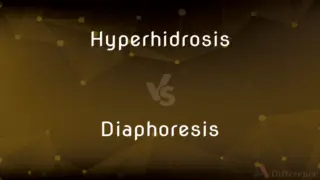Flamenco vs. Tango — What's the Difference?
By Tayyaba Rehman & Urooj Arif — Updated on March 31, 2024
Flamenco is a passionate and expressive Spanish dance and music style characterized by hand clapping, percussive footwork, and intricate movements, while Tango, originating from Argentina, is known for its sensual close embrace, complex footwork.

Difference Between Flamenco and Tango
Table of Contents
ADVERTISEMENT
Key Differences
While flamenco's roots are deeply embedded in the Gypsy culture of Spain, incorporating elements from Jewish, Moorish, and Andalusian traditions, tango has a more cosmopolitan genesis, with influences from European, African, and indigenous cultures. This makes tango a reflection of the melting pot of Buenos Aires during the massive immigration waves of the late 19th and early 20th centuries.
The performance settings for these dances also differ: flamenco can be seen in various contexts from traditional tablaos and informal gatherings known as juergas to large-scale theaters. Tango, traditionally danced in milongas (tango dance events), has also found its way onto international stages, captivating audiences with its sophisticated choreography and the intimate connection between partners.
The attire reflects each dance's character; flamenco dancers often wear colorful, frilly dresses designed to accentuate their movements, while tango dancers typically opt for elegant and sleek outfits that allow for close connection and fluidity in movements.
In essence, while both flamenco and tango are expressive and deeply cultural dances, they diverge significantly in their origins, styles, and emotional expressions, each captivating in its unique way.
Comparison Chart
Origin
Andalusian region of Spain
Buenos Aires, Argentina
ADVERTISEMENT
Components
Cante, Toque, Baile, Palmas
Dance, Music (notably Bandoneón)
Cultural Influences
Gypsy, Jewish, Moorish, Andalusian
European, African, Indigenous
Expression
Emotional intensity, expressive movements
Sensual close embrace, complex footwork
Performance Setting
Tablaos, Theaters, Juergas
Milongas, Theaters
Attire
Colorful, frilly dresses
Elegant, sleek outfits
Musical Instruments
Guitar, Cajón, Palmas
Bandoneón, Piano, Violin
Compare with Definitions
Flamenco
Expresses a range of emotions.
Flamenco can convey deep sorrow or exhilarating joy through its dance and music.
Tango
Accompanied by the melancholic tunes of the bandoneón.
The bandoneón player's melody set the mood for the evening's tango.
Flamenco
A Spanish art form combining dance, song, and music.
The flamenco dancer captivated the audience with her emotional performance.
Tango
Worn with elegant and sleek attire for dancing.
He wore a tailored suit, and she a sleek dress, perfect for a night of tango.
Flamenco
Characterized by foot stomping and hand clapping.
The rhythmic footwork and palmas in flamenco create its unique sound.
Tango
Emphasizes connection and emotion between partners.
Tango is as much about the emotional connection as it is about the steps.
Flamenco
Often performed in colorful, flowing dresses.
She wore a stunning red flamenco dress adorned with ruffles.
Tango
Features close embraces and complex footwork.
Tango dancers often perform in a close hold, executing intricate leg actions.
Flamenco
Involves guitar music and sometimes singing.
The flamenco guitarist's toque added depth to the cante performance.
Tango
An Argentine dance known for its sensuality and intricate steps.
The couple's tango was filled with passionate embraces and precise movements.
Flamenco
Flamenco (Spanish pronunciation: [flaˈmeŋko]), in its strictest sense, is an art form based on the various folkloric music traditions of southern Spain, originating in the culture and traditions of the Calé Roma, commonly known in Spanish as Gitanos, of the region of Andalusia, but also having a historical presence in Extremadura and Murcia. In a wider sense, the term is used to refer to a variety of Spanish and Roma musical styles.
Tango
Tango is a partner dance, and social dance that originated in the 1880s along the Río de la Plata, the natural border between Argentina and Uruguay. It was born in the impoverished port areas of these countries, in neighborhoods which had predominantly African descendants.
Flamenco
A dance style of the Andalusian Romani people, characterized by forceful, often improvised rhythms.
Tango
A dance of Argentine origin for couples in 2/4 or 4/4 time.
Flamenco
A dance in this style.
Tango
The music for this dance.
Flamenco
The guitar music that usually accompanies a dance in this style.
Tango
To perform this dance.
Flamenco
(uncountable) A genre of folk music and dance native to Andalusia, in Spain.
Tango
A standard ballroom dance in 4/4 time; or a social dance, the Argentine tango.
Flamenco
(countable) A song or dance performed in such a style.
Tango
(usually plural) A Spanish flamenco dance with different steps from the Argentine.
Flamenco
(intransitive) To dance flamenco.
Tango
A piece of music suited to such a dance.
Flamenco
A strongly rhythmic and vigorous style of dancing characteristic of the Andalusian gypsies, characterized by clapping and stamping of feet.
Tango
A dark orange colour shade; deep tangerine
Flamenco
A strongly rhythmic style of music originating in southern Spain, often improvisatorial, performed by itself, often on a guitar, or as an accompaniment to flamenco dancing.
Tango
(international standards) nodot=1 NATO/ICAO Phonetic Alphabet.}}
Flamenco
Guitar music composed for dancing the flamenco
Tango
Target.
Flamenco
A style of dancing characteristic of the Andalusian gypsies; vigorous and rhythmic with clapping and stamping of feet
Tango
To dance the tango.
Tango
To mingle or interact (with each other).
Tango
A difficult dance in two-four time characterized by graceful posturing, frequent pointing positions, and a great variety of steps, including the cross step and turning steps. The dance is of Spanish origin, and is believed to have been in its original form a part of the fandango.
Tango
A ballroom dance of Latin-American origin
Tango
Music written in duple time for dancing the tango
Tango
Dance a tango
Common Curiosities
How do the emotional expressions of Flamenco and Tango differ?
Flamenco expresses a broad emotional spectrum from joy to sorrow through its dynamic movements, while Tango often conveys deep passion and nostalgia within its sensual and intimate choreography.
What are the key musical instruments in Flamenco and Tango?
Flamenco music typically features the guitar, cajón, and palmas. Tango music is notably characterized by the bandoneón, along with the piano and violin.
What is Flamenco?
Flamenco is a traditional Spanish art form involving dance, music, and singing, characterized by its emotional intensity and expressive movements.
Can Flamenco and Tango be performed solo?
Flamenco can be performed solo, focusing on the dancer's expressiveness, while Tango is primarily a partner dance, emphasizing the connection between the dancers.
Where are Flamenco and Tango traditionally performed?
Flamenco is traditionally performed in tablaos, theaters, and at juergas, while Tango is danced at milongas and on theater stages worldwide.
How do Flamenco and Tango reflect their cultural origins?
Flamenco reflects the diverse cultural influences of Spain's Andalusian region, incorporating elements from Gypsy, Jewish, and Moorish traditions. Tango mirrors the cosmopolitan culture of Buenos Aires, blending European, African, and indigenous influences.
What is Tango?
Tango is a dance that originated in Argentina, known for its sensual movements, close embrace, and complex footwork.
Are Flamenco and Tango recognized internationally?
Yes, both Flamenco and Tango have gained international recognition and are celebrated worldwide for their cultural significance and artistic beauty.
What kind of attire is associated with Flamenco and Tango?
Flamenco dancers often wear colorful, frilly dresses, whereas Tango dancers opt for elegant and sleek outfits to facilitate their close embrace and movements.
What makes Flamenco and Tango unique compared to other dance forms?
Flamenco is unique for its combination of dance, music, and song, along with its emotional expressiveness and percussive elements. Tango stands out for its intimate embrace, emotional depth, and the intricate, fluid movements shared between partners.
Share Your Discovery

Previous Comparison
Hyperhidrosis vs. Diaphoresis
Next Comparison
Create vs. CraftAuthor Spotlight
Written by
Tayyaba RehmanTayyaba Rehman is a distinguished writer, currently serving as a primary contributor to askdifference.com. As a researcher in semantics and etymology, Tayyaba's passion for the complexity of languages and their distinctions has found a perfect home on the platform. Tayyaba delves into the intricacies of language, distinguishing between commonly confused words and phrases, thereby providing clarity for readers worldwide.
Co-written by
Urooj ArifUrooj is a skilled content writer at Ask Difference, known for her exceptional ability to simplify complex topics into engaging and informative content. With a passion for research and a flair for clear, concise writing, she consistently delivers articles that resonate with our diverse audience.
















































